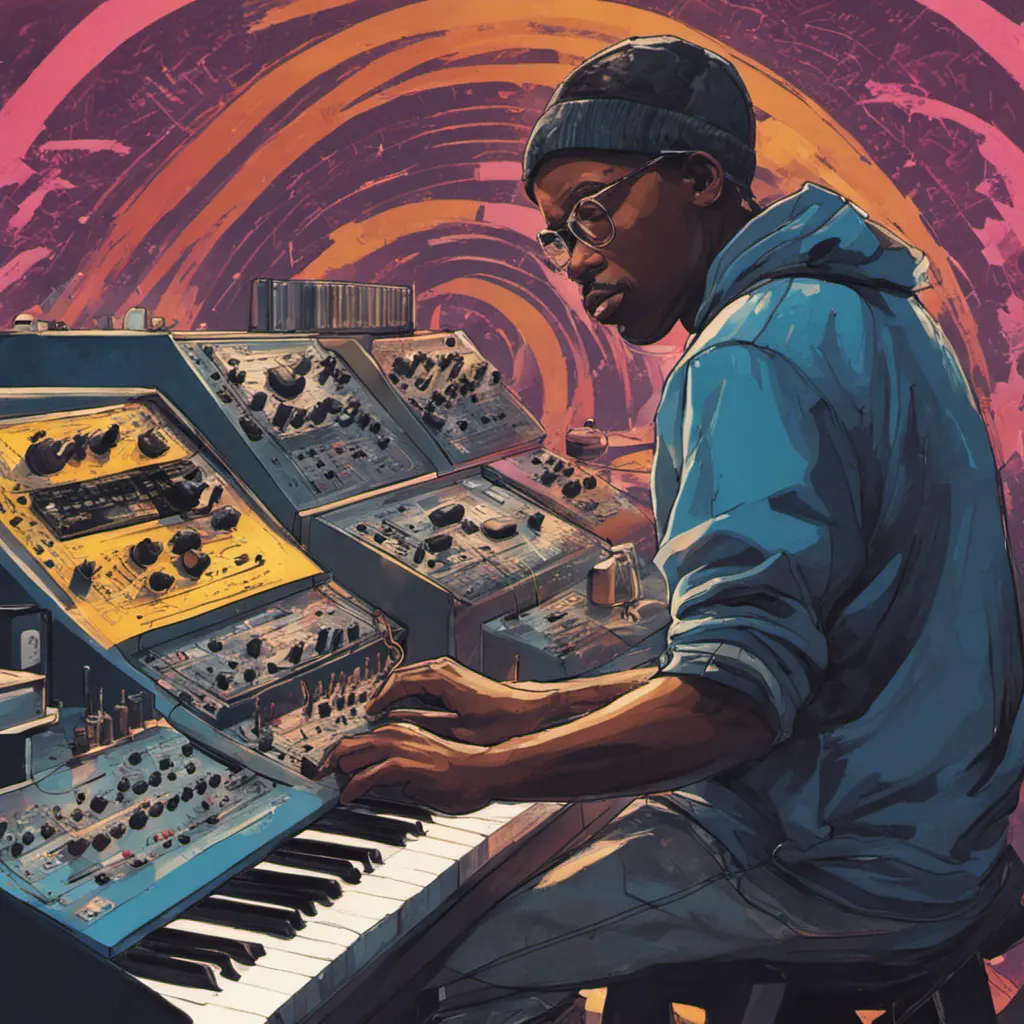MOOG Synth
Understanding the MOOG Synthesizer's history and impact within music.
The MOOG Synthesizer has made an enduring impact on the history of electronic music. Created by Dr. Robert Moog in the 1960s, this groundbreaking instrument revolutionized sound creation and composition. The MOOG Synthesizer introduced a new era of sonic exploration, pushing the boundaries of what was possible in music production. It not only transformed the way musicians approached sound but also shaped the entire landscape of electronic music, leaving an indelible legacy that continues to inspire artists to this day. We can safely also assume that most artists today would have never made music if synths were not created and digital production didn’t evolve as it did.
The MOOG Synthesizer's impact goes beyond its technical capabilities. It sparked a cultural shift, challenging traditional notions of music and paving the way for experimental and avant-garde compositions. The instrument's ability to produce otherworldly sounds and textures captured the imagination of musicians and listeners alike, opening up new possibilities for sonic expression. As a result, the MOOG Synthesizer became synonymous with innovation and artistic freedom, forever changing the trajectory of electronic music.
Invention and Early Development
The story of the MOOG Synthesizer began in the mid-1960s when Dr. Robert Moog, an engineer and physicist, introduced the first commercially available modular synthesizer. Inspired by the innovative work of composers like Wendy Carlos and Herbert Deutsch, Moog envisioned a versatile instrument capable of generating and manipulating electronic sounds. In 1964, he introduced the Moog Modular Synthesizer, the initial version of the MOOG Synthesizer.
The modular system consisted of various modules, including oscillators, filters, amplifiers, and envelope generators. These modules could be interconnected using patch cables, enabling musicians to modify parameters and create a seemingly infinite space of unique sounds. The Moog Modular Synthesizer quickly gained popularity among avant-garde musicians and experimental composers who embraced its ability to produce entirely new sonic textures.
The modular nature of the instrument allowed for flexibility and customization. Musicians could add or rearrange modules to suit their needs, resulting in a highly personalized instrument. This aspect of the MOOG Synthesizer fostered creativity and encouraged musicians to explore new sonic territories. Additionally, Moog's commitment to user-friendly design made the synthesizer more accessible, enabling artists with limited technical knowledge to harness its immense potential.
The groundbreaking nature of the MOOG Synthesizer paved the way for a new era in music production and composition. Its impact would soon extend far beyond the confines of the experimental music scene. A huge example of people who use the MOOG synthesizer are Pink Floyd with Wish You Were Here and The Weeknd.

Popularization and Cultural Impact
The breakthrough moment for the MOOG Synthesizer came in 1968 with the release of Wendy Carlos' album "Switched-On Bach." Carlos, a classically trained musician, utilized the Moog Modular Synthesizer to create electronic renditions of Johann Sebastian Bach's compositions. The album became an unexpected hit, reaching high positions on the charts and introducing the wider public to the distinctive sound of the MOOG Synthesizer. With an album like this, a new idea got the fame, which is creating music using electronic instruments.
The success of "Switched-On Bach" triggered a burst of interest in the MOOG Synthesizer among musicians and the general public alike. Artists from diverse genres, including rock, pop, and jazz, started incorporating the synthesizer into their music. Respected bands and legends in the music scene like The Beatles, The Rolling Stones, and Pink Floyd integrated the MOOG Synthesizer to add futuristic and otherworldly elements to their songs. Its unique sound became synonymous with the progressive and experimental nature of the era, defining the music style of the late 1960s and early 1970s.
The widespread use of the MOOG Synthesizer also sparked innovation and pushed the boundaries of music production. Musicians began experimenting with new techniques, exploiting the synthesizer's capabilities to create unconventional sounds and sonic textures. This sonic experimentation, driven by the MOOG Synthesizer, led to the coming up of new genres and subgenres, contributing to the evolution of electronic music as a whole.
The cultural impact of the MOOG Synthesizer extended beyond the music industry. It found its way into mainstream media, influencing film scores, sound design, and even academic research. The instrument's ability to shape and manipulate sound made it a versatile tool in various creative disciplines, leaving an indelible mark on the broader cultural landscape.
Legacy and Contemporary Use
While the popularity of the MOOG Synthesizer started falling off in the late 1970s with the rise of digital synthesizers, its impact on electronic music remained undeniable. The instrument's legacy and history can be heard in countless genres and subgenres, ranging from ambient and techno to hip-hop and contemporary pop. Artists like Kraftwerk, Gary Numan, and Daft Punk have all utilized the MOOG Synthesizer in their music, ensuring its influence endures to this day.
In recent years, there has been a resurfacing of interest in analog synthesizers, and MOOG instruments have experienced a renaissance. Since people are getting more interested in being “Vintage” and “Old” like having vinyl, or a 1970s car, starting to explore again the MOOG synthesizer is only natural. The company, now known as Moog Music, continues to produce high-quality synthesizers, both in modular and compact formats, catering to the needs of modern musicians and producers. The organic character of the MOOG sound remains highly sought after in the digital age, reflecting the enduring appeal of this groundbreaking instrument.
Furthermore, the impact of the MOOG Synthesizer extends beyond the realm of music production. The instrument's ability to shape and manipulate sound has made it a versatile tool in various creative disciplines, expanding its reach and leaving an indelible mark on the broader cultural landscape.

Conclusion
To conclude this article, we can safely say that the MOOG synthesizer is one of the most revolutionary instruments developed in the last 100 years. To have legends in the scene, The Beatles, Weeknd, Daft Punk, and Pink Floyd, use the MOOG synth and synths derived from that one is a testament to the power of innovation and its profound impact on electronic music.
Starting with Dr. Robert Moog, and having a breakthrough with Wendy Carlos’ album, it definitely has a story behind its success.
From its inception as a groundbreaking modular system to its ongoing relevance in contemporary music production, the MOOG Synthesizer has pushed the boundaries of what is possible in sound creation. It's unique sound and versatile capabilities have influenced generations of musicians and continue to shape the sonic landscape today.
Sources:
- Moog Music. Available at: www.moogmusic.com/
- "Switched-On Bach and the Moog Synthesizer.": www.electronicsound.co.uk/switched-on-bach-and-the-moog-synthesizer/’
- Sound on Sound: The History Of Moog Synthesizers - https://www.soundonsound.com/techniques/history-moog-synthesizers
- Reverb: The Moog Synthesizer: An Icon of Electronic Music - https://reverb.com/news/the-moog-synthesizer-an-icon-of-electronic-music
- All About Jazz: Bob Moog: The Man Behind the Synthesizer - https://www.allaboutjazz.com/bob-moog-the-man-behind-the-synthesizer-by-david-rickert.php
Blog Article Tags
sound creation composition era sonic exploration boundaries productionMore Articles
Where To Find Good Indie Music - If you're a long time fan or first time listener of Indie music, we'll show you the best methods for discovering the music you love.
Top French Music Influencers - Get an inside look at French musical artists who made an impact in the world of music.
How Do I Get Into Indie Music? - Learn how to get started as either a fan or creator of indie music.
How to Become a Successful Independent Musician - Independent Musicians
The Rise of DIY Culture In Indie Music - Becoming part of the DIY indie music culture is now becoming a hotbed of success.


